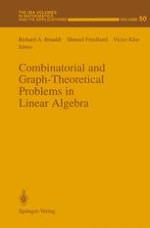This IMA Volume in Mathematics and its Applications COMBINATORIAL AND GRAPH-THEORETICAL PROBLEMS IN LINEAR ALGEBRA is based on the proceedings of a workshop that was an integral part of the 1991-92 IMA program on "Applied Linear Algebra." We are grateful to Richard Brualdi, George Cybenko, Alan George, Gene Golub, Mitchell Luskin, and Paul Van Dooren for planning and implementing the year-long program. We especially thank Richard Brualdi, Shmuel Friedland, and Victor Klee for organizing this workshop and editing the proceedings. The financial support of the National Science Foundation made the workshop possible. A vner Friedman Willard Miller, Jr. PREFACE The 1991-1992 program of the Institute for Mathematics and its Applications (IMA) was Applied Linear Algebra. As part of this program, a workshop on Com binatorial and Graph-theoretical Problems in Linear Algebra was held on November 11-15, 1991. The purpose of the workshop was to bring together in an informal setting the diverse group of people who work on problems in linear algebra and matrix theory in which combinatorial or graph~theoretic analysis is a major com ponent. Many of the participants of the workshop enjoyed the hospitality of the IMA for the entire fall quarter, in which the emphasis was discrete matrix analysis.
